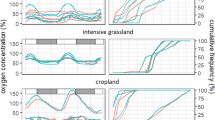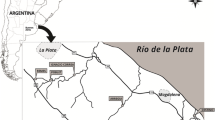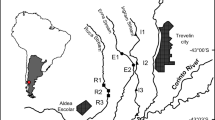Abstract
Three streams in the Piedmont ecoregion of North Carolina were studied to evaluate the effect of land use (forested, agricultural, urban) on water quality and aquatic biota. In comparison with the forested stream, there were few changes in water quality at the agricultural and urban streams. Suspended-sediment yield was greatest for the urban catchment and least at the forested catchment. Suspended-sediment concentrations during storm events followed this same pattern, but at low-moderate flows suspended-sediment concentrations were greatest at the agricultural site. Most nutrient concentrations were highest at the agricultural site, and the amount of ‘available’ dissolved nitrogen was elevated at both the urban and agricultural sites. High concentrations of metals (totals) in the water column were sometimes observed at all sites, but maximum average concentrations were recorded at the urban site (especially Cr, Cu, and Pb). Maximum sediment metal concentrations, however, were not found at the urban site, but were usually recorded at the forested site. Only minor differences were noted between fish communities of the forested and agricultural sites, although both abundance and average size of some species increased at the agricultural site. The fish community at the urban site was characterized by low species richness, low biomass, and the absence of intolerant species.
Invertebrate taxa richness, a biotic index, and the number of unique invertebrate species (found at only one site) indicated moderate stress (Fair water quality) at the agricultural site and severe stress (Poor water quality) at the urban site. At the agricultural site, declines in taxa richness within intolerant groups were partially offset by increases within tolerant groups. The agricultural stream had the highest abundance values, indicating enrichment. The urban site, however, was characterized by low species richness for most groups and very low abundance values. Analysis of seasonal patterns suggested detritus was the most important food source for invertebrates in the forested stream, while periphyton was of greater importance in the agricultural stream. Dominant macroinvertebrate groups shifted from Ephemeroptera at the forested site, to Chironomidae at the agricultural site, and Oligochaeta at the urban site. There was little between-site overlap in dominant species (8–7%), indicating that land use strongly influenced the invertebrate community. Chemical and physical parameters measured at the three sites did not seem sufficient to account for all of the observed differences in the invertebrate communities, suggesting some unmeasured toxicity. Biological measurements, especially macroinvertebrates community structure, consistently indicated strong between-site differences in water and habitat quality.
Similar content being viewed by others
References
Baker, J. L., 1983. Agricultural areas as nonpoint sources of pollution. In Overcash, M. R. & J. M. Davidson (eds), Environmental impact of nonpoint source pollution. Ann Arbor Science, Ann Arbor, MI.: 275–310.
Baker, J. L. & H. P. Johnson, 1983. Evaluating the effectiveness of BMP's from field studies. In Bailey, G. W. & F. W. Schaller (eds), Agricultural management and water quality. Iowa State Univ. Press, Ames, Iowa: 281–304.
Benke, A. C., G. E. Willke, F. K. Parrish & D. L. Stites, 1981. Effects of urbanization on stream ecosystems. Georgia Institute of Technology. ERC 07-81, 64 pp.
Besch, W. K., I. Schreiber & D. Herbst, 1977. Der Hydropsyche — toxizitatstest, erprobt an Fenethcarb. Schweiz. Z. Hydrol. 39: 69–85.
Cole, R. H., R. E. Frederick, R. P. Healy & R. G. Rolan, 1984. Preliminary findings of the priority pollutant monitoring project of the National Urban Runoff Program. J. Wat. Pollut. Cont. Fed. 56: 898–908.
Cook, W. L., F. K. Parrish, J. D. Satterfield, W. G. Nolan & P. E. Gafney, 1983. Biological and chemical assessment of nonpoint source runoff pollution in Georgia: ridge-valley and sea island streams. Georgia State University, Dept. Biology, 175 pp.
Crawford, J. K. & D. R. Lenat, 1989. Effects of land use on the water quality and biota of three streams in the piedmont province of North Carolina. US Geological Survey, Water Resources Investigations Report 89–4007: 1–67.
Dance, K. W. & H. B. N. Hynes, 1980. Some effects of agricultural land use on stream insect communities. Envir. Pollut. Series A 22: 19–28.
Daniels, R. B. et al., 1984. Soil systems in North Carolina. North Carolina Agricultural Res. Service Bull. 467, 77 pp.
Fausch, K. D., J. R. Karr & P. R. Yant, 1984. Regional application of an index of biotic integrity based on stream fish communities. Trans. Am. Fish. Soc. 113: 39–55.
Georgia Department of Natural Resources, 1983. Georgia nonpoint source impact assessment study. Final report from CTA, Inc., 314 pp.
Hilsenhoff, W. L., 1987. An improved biotic index of organic stream pollution. Great Lakes Ent. 20: 31–39.
Hornig, C. E. & J. E. Pollard, 1978. Macroinvertebrate sampling techniques for streams in semi-arid regions: comparison of the Surber method and unit-effort traveling kick method. US EPA, EPA 600/4-78-040, 21 pp.
Johnson, B. T., 1986. Potential impact of selected agricultural chemical contaminants on a northern prairie wetland: a microcosm evaluation. Envir. Toxicol. Chem. 5: 473–485.
Jones, R. C. & C. C. Clark, 1987. Impact of watershed urbanization on stream insect communities. Wat. Res. Bull. 23: 1047–1055.
Karr, J. R., 1981. Assessment of biotic integrity using fish communities. Fisheries 6: 21–27.
Kelly, M. H. & R. L. Hite, 1984. Evaluation of Illinois stream sediment data: 1974–1980. Illinois EPA, IEPA/WPC/84-004, 103 pp.
Klein, R. D., 1979. Urbanization and stream quality impairment. Wat. Res. Bull. 15: 948–963.
Klein, R. D., 1985. Effects of urbanization upon aquatic resources. Maryland Department of Natural Resources.
Lemly, A. D., 1985. Suppression of native fish species by green sunfish in first order streams of piedmont North Carolina. Trans. Am. Fish. Soc. 114: 705–712.
Lenat, D. R., 1984. Agriculture and stream water quality: a biological evaluation of erosion control practices. Envir. Mgmt. 8: 333–344.
Lenat, D. R., 1988. Water quality assessment of streams using a qualitative collection method for benthic macroinvertebrates. J. North Am. Benthol. Soc. 7: 222–233.
Lenat, D. R., 1993. A biotic index for the southeastern United States: derivation and list of tolerance values, with criteria for assigning water-quality ratings. J. North Am. Benthol. Soc. 12: 279–290.
Lenat, D. R. & K. W. Eagleson, 1981. Ecological effects of urban runoff on North Carolina streams. North Carolina Division of Environmental Management, Biological Series #104, 22 pp.
Loehr, R. C., 1974. Characteristics and comparative magnitude of nonpoint sources. J. Wat. Pollut. Cont. Fed. 46: 1849–1872.
Mason, W. T., Jr. & P. P. Yevich, 1967. The use of phloxine B and rose Bengal stains to facilitate sorting benthic samples. Trans. am. Microsc. Soc. 86: 221–223.
Medeiros, C., R. LeBlanc & R. A. Coler, 1983. An in situ assessment of the acute toxicity of urban runoff to benthic macroinvertebrates: Envir. Toxicol. Chem. 2: 119–126.
Merritt, R. W. & K. W. Cummins, 1978. An introduction to the aquatic invertebrates of North America. Kendall Hunt Publishing Co., Dubuque, Iowa, 441 pp.
Messer, J. B., J. R. Davis, T. E. Crowell & W. C. Carnes, 1965. Survey and classification of the Broad River and tributaries, North Carolina. NC Wildlife Resources Commission, Division of Inland Fisheries, 21 pp.
North Carolina Department of Natural Resources and Community Development, 1979. Water quality management plan — executive summary. 27 pp.
North Carolina Division of Environmental Management, 1982. Agriculture and stream water quality: a biological evaluation of erosion control practices. Biological Series No. 107.
Norusis, M. J., 1983. Introductory statistics guide SPSSX. McGraw Hill, New York, 276 pp.
Omernik, J. M., 1977. Nonpoint source stream nutrient level relationships: a nationwide study. US EPA Ecological Research Series EPA-600/3-77-105, 151 pp.
Penrose, D. L., D. R. Lenat & K. W. Eagleson, 1980. Biological evaluation of water quality in North Carolina streams and rivers. NC Division of Environmental Management. Biological Series No. 103, 181 pp.
Pitt, R. & M. Bozeman, 1980. Water quality and biological degradation in an urban creek. In: Yousef, Y. A., M. P. Wanielista, W. M. McLellon & J. S. Taylor (eds) Urban stormwater and combined sewer overflow impact on receiving water bodies. EPA 600/9-80-056: 371–403.
Porter, K. S., 1980. An evaluation of sources of nitrogen as causes of ground-water contamination in Nassau County, Long Island. Ground Water 18: 617–625.
Quinn, J. M., R. B. Williamson, R. K. Smith & M. L. Vickers. 1992. Effects of riparian grazing and channelization on streams in Southland, New Zealand. 2. Benthic macroinvertebrates. N. Zeal. J. mar. Freshwat. Res. 26: 259–273.
Ramande, F., R. Cosson, M. Echaubard, S. Lebras, J. C. Moreteau & E. Tbybaud, 1984. Detection de la pollution des eaux en milieu agricole. Bull. Ecol. 15: 21–37.
Richards, C., G. E. Host & J. W. Arthur. 1993. Identification of predominant environmental factors structuring stream macroinvertebrate communities within a large agricultural catchment. Freshwat. Biol. 29: 285–294.
Richards, R. P. & D. B. Baker, 1993. Pesticide concentration patterns in agricultural drainage networks in the Lake Erie basin. Envir. Toxicol. Chem. 12: 13–26.
Schlosser, I. J. & J. R. Karr, 1981. Water quality in agricultural watersheds: impact of riparian vegetation during base flow. Wat. Resour. Bull. 17: 233–240.
Simmons, C. E., 1987. Sediment characteristics of North Carolina streams 1970–1979. US Geological Survey Open-File Report 87-701.
Steele, R. G. D. & J. H. Torrie, 1980. Principles and procedures of statistics: a biometrical approach (2nd edition). New York, McGraw-Hill, 633 pp.
Streit, B. & J. Schwoerbel, 1976. Experimentelle untersuchungen uber die akkumulation und wirkung von herbiziden bei benthischen susswassertieren. Verhandlungen Gessellschaft Okol. Gottingen: 371-383.
Wilber, W. G. & J. V. Hunter, 1977. Aquatic transport of heavy metals in the urban environment. Wat. Resour. Bull. 13: 721–734.
Winner, R. W., M. W. Boesel & M. P. Farrell, 1980. Insect community structure as an index of heavy metal pollution in lotic ecosystems. Can J. Fish. Aquat. Sci. 37: 647–655.
Author information
Authors and Affiliations
Rights and permissions
About this article
Cite this article
Lenat, D.R., Crawford, J.K. Effects of land use on water quality and aquatic biota of three North Carolina Piedmont streams. Hydrobiologia 294, 185–199 (1994). https://doi.org/10.1007/BF00021291
Received:
Revised:
Accepted:
Issue Date:
DOI: https://doi.org/10.1007/BF00021291




